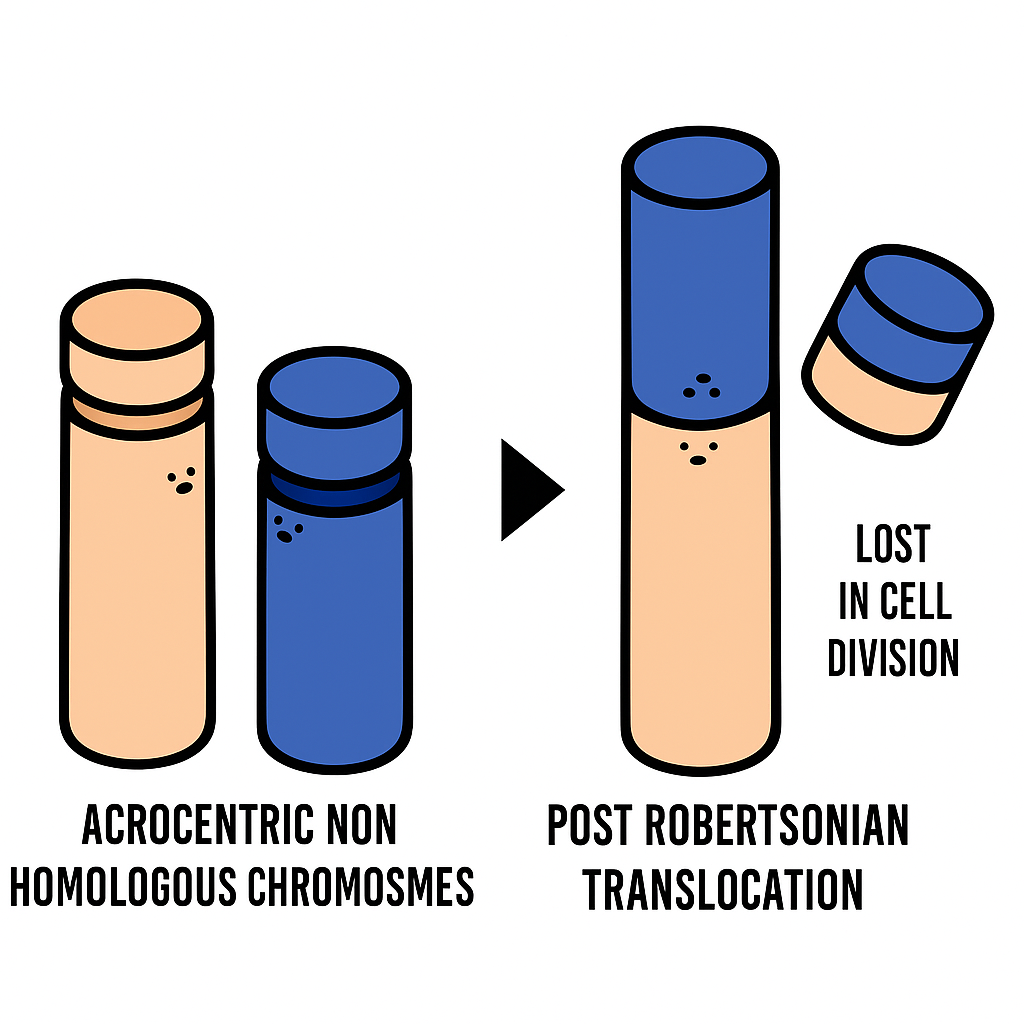Genetic Mutations - Introductory Genetics: Alexandra D. Simmons N., PhD.
1/62
Earn XP
Description and Tags
Mutations are permanent, heritable changes in DNA sequences. They are not detected as errors by DNA polymerase and won’t be repaired by normal mechanisms. Mutations can be beneficial, harmful, or neutral—most are neutral. Importantly, even a single base pair change means the entire DNA sequence is considered mutated. Image credit: “Robertsonian translocation diagram” by Splette (Wikimedia Commons), CC BY 4.0, modified with added labels.
Name | Mastery | Learn | Test | Matching | Spaced |
|---|
No study sessions yet.
63 Terms
Point mutation
Mutation that impacts a single base-pair (deletion, insertion, or base substitution).
Chromosomal Rearrangements
Change in structure of chromosome(s), may consist of many sub mutations. Can involve multiple chromosomes or even result in changes to ploidy number (number of sets of chromosomes).
Base substitution
Mutation in which one nucleotide is replaced with another. (Only one base pair has been modified)
Transition
Specific base substitution in which a pyrimidine is changed for another pyrimidine, or a purine is changed for another purine.
Transversion
Specific base substitution in which a pyrimidine is changed for a purine or vice versa.
Deletion(s)
Removal of one or more nucleotides.
Insertion
Addition of one or more nucleotides.
Indels
Either insertion or deletion of nucleotides (can range from just 1 base pair to a sequence of several Mb of genomic sequence—millions of base pairs).
In-frame
Nucleotide addition or deletion, multiples of 3 (3, 6, 9, …). Do not affect the reading frame.
Frameshift
Addition or deletion of nucleotides that changes the reading frame (not a multiple of 3 base pairs).
Dynamic repeats / Dynamic mutations
Mutation caused by unstable expansions of microsatellites, repeating units of 3 to 6 nucleotides. (Diseases caused by this show “anticipation,” where the disease manifests earlier and severity increases with each generation.)
Transposition
Mutation caused by the movement of a transposon from one genomic locus to another.
Missense mutation
Change of a codon for a non-synonymous codon.
Conservative substitution
Missense mutation that changes the original amino acid to another with similar properties.
Nonconservative substitution
Missense mutation that changes the original amino acid to another with different properties.
Neutral mutation
Missense mutation similar to a conservative substitution: the change of amino acid does not significantly impact the function of the protein.
Silent mutation
Change of a codon for a synonymous codon. Even though the DNA sequence has changed, the primary structure of the protein does not.
Nonsense mutation
Change of a sense codon for a non-sense codon (stop codon). Leads to early termination of protein synthesis, producing a truncated protein or no protein at all.
Loss of function mutation
Mutation that can: inactivate a regulatory sequence, eliminate protein synthesis, or produce a nonfunctional (or reduced-function) protein.
Gain of function mutation
Rare mutation which allows a protein to acquire a new function, often detrimental.
Lethal mutation
Mutation that leads to the death of the organism.
Dominant-negative effect
In a heterozygous individual, this mutation produces an altered protein that interferes with the function of the normal protein produced from the normal allele.
Forward mutation
Change of a normal allele (wild-type) to a mutant allele.
Reverse genetics
The method by which specific genes are mutated to observe the consequences.
Reverse mutation
Change of a mutant allele to a normal allele (counteracts forward mutation).
Intragenic suppressor
When the reverse mutation occurs at a different nucleotide in the same gene.
Intergenic suppressor
When the reverse mutation occurs in a different gene.
Somatic mutation
Mutation in any cell, with the exception of germ cells and cells that produce them.
Germline mutation
Mutations in germ cells or the cells that produce them.
Endogenous mutation
Mutation that occurs naturally in living cells.
Exogenous mutation
Mutation caused by an external agent.
Genomic rearrangement
Mutations that involve larger segments of DNA (a few to thousands of nucleotides) that may include coding regions, exons, a gene or group of genes. (Deviations from normal diploid or changes to relative location of genes.)
Genomic disorder
Genetic disease caused by a genomic
